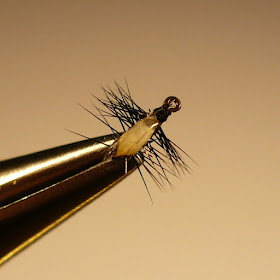PART 3. THE JASSID
Few books have given such an impact on fly fishing as "A Modern Dry Fly Code" written by Vincent Marinaro and published in 1950. There he presented "The Jassid" as an imitation of various terrestrials. Today it's normal to use fly patterns that imitate terrestrials like beetles, ants, grasshoppers and so forth. But at that time it wasn't. So this work was ground breaking. I wonder how he was viewed among fly fishermen in general. Was he viewed as some kind of heretic? Probably by some puritans among fly fishermen. But obviously the message got through in time. Imitations of terrestrials were here to stay.
The Jassid Dry Fly is a pretty basic pattern but it has it's drawbacks. The main material, the JC nail, is by it's nature fragile and often split. Furthermore it's not so easy to obtain and is quite expensive. Since the Jassid usually is used in small sizes that makes it even more difficult to obtain suitable material of good quality. In this case hooks, hackle and thread. Can some of these drawbacks be dealt with? Well, yes indeed they can. Let's start with the JC nail. Perhaps you noticed that the jassids in the photo above are quite glossy. It has an explanation.
The JC nails are treated with a cote of Clear Cure Goo Tack Free as shown in the picture above. This resin can fix split nails and reinforce the JC nail so it can last for more than just one trout. I've been treating quite a few of the larger size jassids that I have. The first one I tied with an already cured JC nail is the little bugger in the front on the first picture. It's tied on a Partridge K1A Vince Marinaro Midge Fly Hook size #24. Let's take a closer look at that one.
 |
| From the right hand side |
 |
| From above |
Here it's easy to see that the JC nail have been cured. I'm quite positive that it will make the fly more durable. Probably won't have a chance to test until the next season. Another thing with this fly is that I've used a new thread that I've just obtained. It can be seen in the picture below.
The thread is called "Veevus" and can be found in different colors and strengts. I've used the black 16/0 as seen in the picture and I can really recommend this thread for tying tiny flies. It's the best thread I've ever used for midge flies. Since I've used Uni-Thread Caenis 20/0, Uni-Thread Trico 17/0 and Sheer 14/0 I can certainly recommend this thread. It's is my favorite thread now and it can be used with my favorite bobbin holder (the C&F Midge Bobbin Holder) as seen in the picture also. The thread is incredible strong and makes it easier to tie midge flies with confidence that the thread won't break. It's thin but has a good "bite".
Just couldn't help it. Had to try to tie a Jassid size #32 with the same thread and a JC nail previously cured. Above is the result. I would recommend though the use of Clear Cure Goo Hydro when making really tiny flies since it should be easier to applicate to the smaller nails needed.
Additional methods to make the jassid more durable:
Winding the tying thread a little down the shank and tying in the hackle just a tad in onto the bed of thread to avoid getting the hackle against the hook shank. Otherwise it easily gets cut off when you trim the barbs below the shank.
Cutting off the barbs of the JC nail instead of just stripping it.
Doubling the waist piece of the nail back while tying on the JC nail.
Using varnish, superglue or CCG Hydro finishing the head.
Cure the junction between the JC nail and the head to make it more durable.
Well, some of these suggestions are quite obvious, but since I want that even those that just are entering on the path of enjoying the nature whilst fly fishing to understand, I've tried to make things as clear and understandable as possible.
Hope you enjoyed the post.
Best wishes,
M.O.
Additional methods to make the jassid more durable:
Winding the tying thread a little down the shank and tying in the hackle just a tad in onto the bed of thread to avoid getting the hackle against the hook shank. Otherwise it easily gets cut off when you trim the barbs below the shank.
Cutting off the barbs of the JC nail instead of just stripping it.
Doubling the waist piece of the nail back while tying on the JC nail.
Using varnish, superglue or CCG Hydro finishing the head.
Cure the junction between the JC nail and the head to make it more durable.
Well, some of these suggestions are quite obvious, but since I want that even those that just are entering on the path of enjoying the nature whilst fly fishing to understand, I've tried to make things as clear and understandable as possible.
Hope you enjoyed the post.
Best wishes,
M.O.
CLICK TO ENLARGE THE PHOTOS




Nice Mats! And a good tip... How do you find the K1A hooks? Some say they're brittle but I've never had issues, and the history is special for small fly freaks who share an interest.
SvaraRaderaBest,
Andy
Thanks! Well I'm trying to restock the K1A myself but since they are discontinued it's hard to find them. I've bought some on eBay. Might be worth a try.
SvaraRaderaGood luck,
Mats Olsson
Wonderful little flies.
SvaraRaderaAnother fitting tribute to the Jungle Cock, and to Vince.
Thanks Alan. Yes, to me his reasoning about fly fishing and the patterns (mostly the Jassid) he developed are of great importance to me.
SvaraRaderaMy best,
Mats Olsson